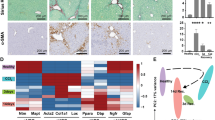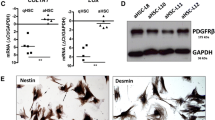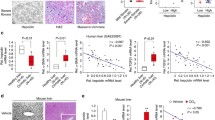Abstract
Trans-differentiation, or activation, of hepatic stellate cells (HSCs) is a hallmark event in liver fibrosis although the underlying mechanism is not fully appreciated. Serum response factor (SRF) is a pleiotropic sequence-specific transcription factor with a ubiquitous expression pattern. In the present study, we investigated the effect of HSC-specific ablation of SRF on liver fibrosis in vivo and the underlying mechanism. We report that SRF bound to the promoter regions of pro-fibrogenic genes, including collagen type I (Col1a1/Col1a2) and alpha smooth muscle actin (Acta2), with greater affinity in activated HSCs compared to quiescent HSCs. Ablation of SRF in HSCs in vitro downregulated the expression of fibrogenic genes by dampening the accumulation of active histone marks. SRF also interacted with MRTF-A, a well-documented co-factor involved in liver fibrosis, on the pro-fibrogenic gene promoters during HSC activation. In addition, SRF directly regulated MRTF-A transcription in activated HSCs. More importantly, HSC conditional SRF knockout (CKO) mice developed a less robust pro-fibrogenic response in the liver in response to CCl4 injection and BDL compared to wild-type littermates. In conclusion, our data demonstrate that SRF may play an essential role in HSC activation and liver fibrosis.
Key messages
• SRF deficiency decelerates activation of hepatic stellate cells (HSCs) in vitro.
• SRF epigenetically activates pro-fibrogenic transcription to promote HSC maturation.
• SRF interacts with MRTF-A and contributes to MRTF-A transcription.
• Conditional SRF deletion in HSCs attenuates BDL-induced liver fibrosis in mice.
• Conditional SRF ablation in HSCs attenuates CCl4-induced liver fibrosis in mice.






Similar content being viewed by others
Abbreviations
- HSC:
-
Hepatic stellate cell
- SRF:
-
Serum response factor
- BDL:
-
Bile duct ligation
- MRTF-A:
-
Myocardin-related transcription factor A
- CKO:
-
Conditional knockout
- ChIP:
-
Chromatin immunoprecipitation
- α-SMA:
-
Alpha smooth muscle actin
References
Zhang X, Hu M, Lyu X, Li C, Thannickal VJ, Sanders YY (2017) DNA methylation regulated gene expression in organ fibrosis. Biochim Biophys Acta 1863:2389–2397
Bochaton-Piallat ML, Gabbiani G, Hinz B (2016) The myofibroblast in wound healing and fibrosis: answered and unanswered questions. F1000Research 5. https://doi.org/10.12688/f1000research.8190.1
Kanisicak O, Khalil H, Ivey MJ, Karch J, Maliken BD, Correll RN, Brody MJ, Lin JSC, Aronow BJ, Tallquist MD et al (2016) Genetic lineage tracing defines myofibroblast origin and function in the injured heart. Nat Commun 7:12260
Seki E, Schwabe RF (2015) Hepatic inflammation and fibrosis: functional links and key pathways. Hepatology 61:1066–1079
Mederacke I, Hsu CC, Troeger JS, Huebener P, Mu X, Dapito DH, Pradere JP, Schwabe RF (2013) Fate tracing reveals hepatic stellate cells as dominant contributors to liver fibrosis independent of its aetiology. Nat Commun 4:2823
Friedman SL (2010) Evolving challenges in hepatic fibrosis. Nat Rev Gastroenterol Hepatol 7:425–436
Miano JM (2010) Role of serum response factor in the pathogenesis of disease. Lab Investig 90:1274–1284
Miano JM (2003) Serum response factor: toggling between disparate programs of gene expression. J Mol Cell Cardiol 35:577–593
Wang DZ, Li S, Hockemeyer D, Sutherland L, Wang Z, Schratt G, Richardson JA, Nordheim A, Olson EN (2002) Potentiation of serum response factor activity by a family of myocardin-related transcription factors. Proc Natl Acad Sci U S A 99:14855–14860
Small EM (2012) The actin-MRTF-SRF gene regulatory axis and myofibroblast differentiation. J Cardiovasc Transl Res 5:794–804
Tagalakis AD, Madaan S, Larsen SD, Neubig RR, Khaw PT, Rodrigues I, Goyal S, Lim KS, Yu-Wai-Man C (2018) In vitro and in vivo delivery of a sustained release nanocarrier-based formulation of an MRTF/SRF inhibitor in conjunctival fibrosis. J Nanobiotechnol 16:97
Fernando O, Tagalakis AD, Awwad S, Brocchini S, Khaw PT, Hart SL, Yu-Wai-Man C (2018) Development of targeted siRNA nanocomplexes to prevent fibrosis in experimental glaucoma filtration surgery. Mol Ther 26:2812–2822
Yu-Wai-Man C, Tagalakis AD, Manunta MD, Hart SL, Khaw PT (2016) Receptor-targeted liposome-peptide-siRNA nanoparticles represent an efficient delivery system for MRTF silencing in conjunctival fibrosis. Sci Rep 6:21881
Sisson TH, Ajayi IO, Subbotina N, Dodi AE, Rodansky ES, Chibucos LN, Kim KK, Keshamouni VG, White ES, Zhou Y, Higgins PDR, Larsen SD, Neubig RR, Horowitz JC (2015) Inhibition of myocardin-related transcription factor/serum response factor signaling decreases lung fibrosis and promotes mesenchymal cell apoptosis. Am J Pathol 185:969–986
Jiang M, Ku WY, Fu J, Offermanns S, Hsu W, Que J (2013) Gpr177 regulates pulmonary vasculature development. Development 140:3589–3594
Zheng J, Mao Y, Dong P, Huang Z, Yu F (2019) Long noncoding RNA HOTTIP mediates SRF expression through sponging miR-150 in hepatic stellate cells. J Cell Mol Med 23:1572–1580
You K, Li SY, Gong J, Fang JH, Zhang C, Zhang M, Yuan Y, Yang J, Zhuang SM (2018) MicroRNA-125b promotes hepatic stellate cell activation and liver fibrosis by activating RhoA signaling. Mol Ther Nucleic Acids 12:57–66
Takata A, Otsuka M, Kishikawa T, Yamagami M, Ishibashi R, Sekiba K, Suzuki T, Ohno M, Yamashita Y, Abe T et al (2017) RASAL1 is a potent regulator of hepatic stellate cell activity and liver fibrosis. Oncotarget 8:64840–64852
Guo B, Lyu Q, Slivano OJ, Dirkx R, Christie CK, Czyzyk J, Hezel AF, Gharavi AG, Small EM, Miano JM (2018) Serum response factor is essential for maintenance of podocyte structure and function. J Am Soc Nephrol 29:416–422
Li M, Hong W, Hao C, Li L, Wu D, Shen A, Lu J, Zheng Y, Li P, Xu Y (2018) SIRT1 antagonizes liver fibrosis by blocking hepatic stellate cell activation in mice. FASEB J 32:500–511
Li M, Hong W, Hao C, Li L, Xu H, Li P, Xu Y (2017) Hepatic stellate cell-specific deletion of SIRT1 exacerbates liver fibrosis in mice. Biochim Biophys Acta 1863:3202–3211
Zhou B, Zeng S, Li L, Fan Z, Tian W, Li M, Xu H, Wu X, Fang M, Xu Y (2016) Angiogenic factor with G patch and FHA domains 1 (Aggf1) regulates liver fibrosis by modulating TGF-beta signaling. Biochim Biophys Acta 1862:1203–1213
Tian W, Hao C, Fan Z, Weng X, Qin H, Wu X, Fang M, Chen Q, Shen A, Xu Y (2015) Myocardin related transcription factor A programs epigenetic activation of hepatic stellate cells. J Hepatol 62:165–174
Yang Y, Chen D, Yuan Z, Fang F, Cheng X, Xia J, Fang M, Xu Y, Gao Y (2013) Megakaryocytic leukemia 1 (MKL1) ties the epigenetic machinery to hypoxia-induced transactivation of endothelin-1. Nucleic Acids Res 41:6005–6017
Fang F, Yang Y, Yuan Z, Gao Y, Zhou J, Chen Q, Xu Y (2011) Myocardin-related transcription factor A mediates OxLDL-induced endothelial injury. Circ Res 108:797–807
Li Z, Chen B, Dong W, Xu W, Song M, Fang M, Guo J, Xu Y (2018) Epigenetic activation of PERP transcription by MKL1 contributes to ROS-induced apoptosis in skeletal muscle cells. Biochim Biophys Acta Gene Reg Mech 1861:905–915
Li Z, Chen B, Weng X, Yu L, Song M, Fang M, Guo J, Xu Y (2018) The histone methyltransferase SETD1A regulates thrombomodulin transcription in vascular endothelial cells. Biochim Biophys Acta Gene Reg Mech 1861:752–761
Zeng S, Wu X, Chen X, Xu H, Zhang T, Xu Y (2018) Hypermethylated in cancer 1 (HIC1) mediates high glucose induced ROS accumulation in renal tubular epithelial cells by epigenetically repressing SIRT1 transcription. Biochim Biophys Acta Gene Reg Mech 1861:917–927
Weng X, Zhang Y, Li Z, Yu L, Xu F, Fang M, Hou L, Ge J, Xu Y (2019) Class II transactivator (CIITA) mediates IFN-gamma induced eNOS repression by enlisting SUV39H1. Biochim Biophys Acta Gene Reg Mech 1862:163–172
Shao J, Weng X, Zhuo L, Yu L, Li Z, Shen K, Xu W, Fang M, Xu Y (2019) Angiotensin II induced CSF1 transcription is mediated by a crosstalk between different epigenetic factors in vascular endothelial cells. Biochim Biophys Acta Gene Reg Mech 1862:1–11
Li Z, Zhang X, Liu S, Zeng S, Yu L, Yang G, Guo J, Xu Y (2018) BRG1 regulates NOX gene transcription in endothelial cells and contributes to cardiac ischemia-reperfusion injury. Biochim Biophys Acta Mol basis Dis 1864:3477–3486
Li N, Kong M, Zeng S, Hao C, Li M, Li L, Xu Z, Zhu M, Xu Y (2019) Brahma related gene 1 (Brg1) contributes to liver regeneration by epigenetically activating the Wnt/beta-catenin pathway in mice. FASEB J 33:327–338
Li N, Li M, Hong W, Shao J, Xu H, Shimano H, Lu J, Xu Y (2018) Brg1 regulates pro-lipogenic transcription by modulating SREBP activity in hepatocytes. Biochim Biophys Acta Mol Basis Dis 1864:2881–2889
Li N, Kong M, Zeng S, Xu Z, Li M, Hong W, Chu X, Sun X, Zhu M, Xu Y (2018) The chromatin remodeling protein BRG1 regulates APAP-induced liver injury by modulating CYP3A11 transcription in hepatocyte. Biochim Biophys Acta Mol basis Dis 1864:3487–3495
Luchsinger LL, Patenaude CA, Smith BD, Layne MD (2011) Myocardin-related transcription factor-A complexes activate type I collagen expression in lung fibroblasts. J Biol Chem 286:44116–44125
Small EM, Thatcher JE, Sutherland LB, Kinoshita H, Gerard RD, Richardson JA, Dimaio JM, Sadek H, Kuwahara K, Olson EN (2010) Myocardin-related transcription factor-a controls myofibroblast activation and fibrosis in response to myocardial infarction. Circ Res 107:294–304
McDonald OG, Wamhoff BR, Hoofnagle MH, Owens GK (2006) Control of SRF binding to CArG box chromatin regulates smooth muscle gene expression in vivo. J Clin Invest 116:36–48
Fan Z, Hao C, Li M, Dai X, Qin H, Li J, Xu H, Wu X, Zhang L, Fang M, Zhou B, Tian W, Xu Y (2015) MKL1 is an epigenetic modulator of TGF-beta induced fibrogenesis. Biochim Biophys Acta Gene Reg Mech 1849:1219–1228
Tian W, Fan Z, Li J, Hao C, Li M, Xu H, Wu X, Zhou B, Zhang L, Fang M, Xu Y (2016) Myocardin-related transcription factor A (MRTF-A) plays an essential role in hepatic stellate cell activation by epigenetically modulating TGF-beta signaling. Int J Biochem Cell Biol 71:35–43
Xu H, Wu X, Qin H, Tian W, Chen J, Sun L, Fang M, Xu Y (2015) Myocardin-related transcription factor a epigenetically regulates renal fibrosis in diabetic nephropathy. J Am Soc Nephrol 26:1648–1660
Shilatifard A (2012) The COMPASS family of histone H3K4 methylases: mechanisms of regulation in development and disease pathogenesis. Annu Rev Biochem 81:65–95
Noubade R, Wong K, Ota N, Rutz S, Eidenschenk C, Valdez PA, Ding J, Peng I, Sebrell A, Caplazi P, DeVoss J, Soriano RH, Sai T, Lu R, Modrusan Z, Hackney J, Ouyang W (2014) NRROS negatively regulates reactive oxygen species during host defence and autoimmunity. Nature 509:235–239
Yang Y, Yu X (2003) Regulation of apoptosis: the ubiquitous way. FASEB J 17:790–799
Ribera J, Pauta M, Melgar-Lesmes P, Cordoba B, Bosch A, Calvo M, Rodrigo-Torres D, Sancho-Bru P, Mira A, Jimenez W et al (2017) A small population of liver endothelial cells undergoes endothelial-to-mesenchymal transition in response to chronic liver injury. Am J Physiol Gastrointest Liver Physiol 313:G492–G504
Iwaisako K, Jiang C, Zhang M, Cong M, Moore-Morris TJ, Park TJ, Liu X, Xu J, Wang P, Paik YH, Meng F, Asagiri M, Murray LA, Hofmann AF, Iida T, Glass CK, Brenner DA, Kisseleva T (2014) Origin of myofibroblasts in the fibrotic liver in mice. Proc Natl Acad Sci U S A 111:E3297–E3305
Han X, Hao C, Li L, Li J, Fang M, Zheng Y, Lu J, Li P, Xu Y (2017) HDAC4 stimulates MRTF-A expression and drives fibrogenesis in hepatic stellate cells by targeting miR-206. Oncotarget 8:47586–47594
McDonald OG, Owens GK (2007) Programming smooth muscle plasticity with chromatin dynamics. Circ Res 100:1428–1441
Mikkelsen TS, Xu Z, Zhang X, Wang L, Gimble JM, Lander ES, Rosen ED (2010) Comparative epigenomic analysis of murine and human adipogenesis. Cell 143:156–169
Hanna M, Liu H, Amir J, Sun Y, Morris SW, Siddiqui MA, Lau LF, Chaqour B (2009) Mechanical regulation of the proangiogenic factor CCN1/CYR61 gene requires the combined activities of MRTF-A and CREB-binding protein histone acetyltransferase. J Biol Chem 284:23125–23136
Lockman K, Taylor JM, Mack CP (2007) The histone demethylase, Jmjd1a, interacts with the myocardin factors to regulate SMC differentiation marker gene expression. Circ Res 101:e115–e123
Zhang M, Fang H, Zhou J, Herring BP (2007) A novel role of Brg1 in the regulation of SRF/MRTFA-dependent smooth muscle-specific gene expression. J Biol Chem 282:25708–25716
Yu L, Fang F, Dai X, Xu H, Qi X, Fang M, Xu Y (2017) MKL1 defines the H3K4Me3 landscape for NF-kappaB dependent inflammatory response. Sci Rep 7:191
Liu L, Wu X, Xu H, Yu L, Zhang X, Li L, Jin J, Zhang T, Xu Y (2018) Myocardin-related transcription factor A (MRTF-A) contributes to acute kidney injury by regulating macrophage ROS production. Biochim Biophys Acta Mol Basis Dis 1864:3109–3121
Liu L, Mao L, Wu X, Wu T, Liu W, Yang Y, Zhang T, Xu Y (2019) BRG1 regulates endothelial-derived IL-33 to promote ischemia-reperfusion induced renal injury and fibrosis in mice. Biochim Biophys Acta Mol Basis Dis 1865:2551–2561
Liu L, Hong W, Li M, Ren H, Wang J, Xu H, Shi X, Xu Y (2019) A cross talk between BRG1 and males absent on the first contributes to reactive oxygen species production in a mouse model of nonalcoholic steatohepatitis. Antioxid Redox Signal 30:1539–1552
Weng X, Yu L, Liang P, Li L, Dai X, Zhou B, Wu X, Xu H, Fang M, Chen Q, Xu Y (2015) A crosstalk between chromatin remodeling and histone H3K4 methyltransferase complexes in endothelial cells regulates angiotensin II-induced cardiac hypertrophy. J Mol Cell Cardiol 82:48–58
Zhang X, Liu S, Weng X, Wu T, Yu L, Xu Y, Guo J (2018) Brg1 trans-activates endothelium-derived colony stimulating factor to promote calcium chloride induced abdominal aortic aneurysm in mice. J Mol Cell Cardiol 125:6–17
Wang Y, Zhang L, Li Y, Chen L, Wang X, Guo W, Zhang X, Qin G, He SH, Zimmerman A, Liu Y, Kim IM, Weintraub NL, Tang Y (2015) Exosomes/microvesicles from induced pluripotent stem cells deliver cardioprotective miRNAs and prevent cardiomyocyte apoptosis in the ischemic myocardium. Int J Cardiol 192:61–69
Funding
This work was supported, in part, by grants from the National Natural Science Foundation of China (81725001, 81700554, 81770487), from the Nanjing Municipal Administration of Health and Human Services (YKK17061), from the Fundamental Research Funds for Central Universities (021414380323), and from the Haihan Province R&D Fund Key Project (ZDYF2018102).
Author information
Authors and Affiliations
Corresponding authors
Ethics declarations
All the animal protocols were reviewed and approved by the intramural Ethics Committee on Humane Treatment of Experimental Animals.
Conflict of interest
The authors declare that they have no competing interests.
Additional information
Publisher’s note
Springer Nature remains neutral with regard to jurisdictional claims in published maps and institutional affiliations.
Electronic supplementary material
ESM 1
(DOCX 558 kb)
Rights and permissions
About this article
Cite this article
Kong, M., Hong, W., Shao, Y. et al. Ablation of serum response factor in hepatic stellate cells attenuates liver fibrosis. J Mol Med 97, 1521–1533 (2019). https://doi.org/10.1007/s00109-019-01831-8
Received:
Revised:
Accepted:
Published:
Issue Date:
DOI: https://doi.org/10.1007/s00109-019-01831-8




